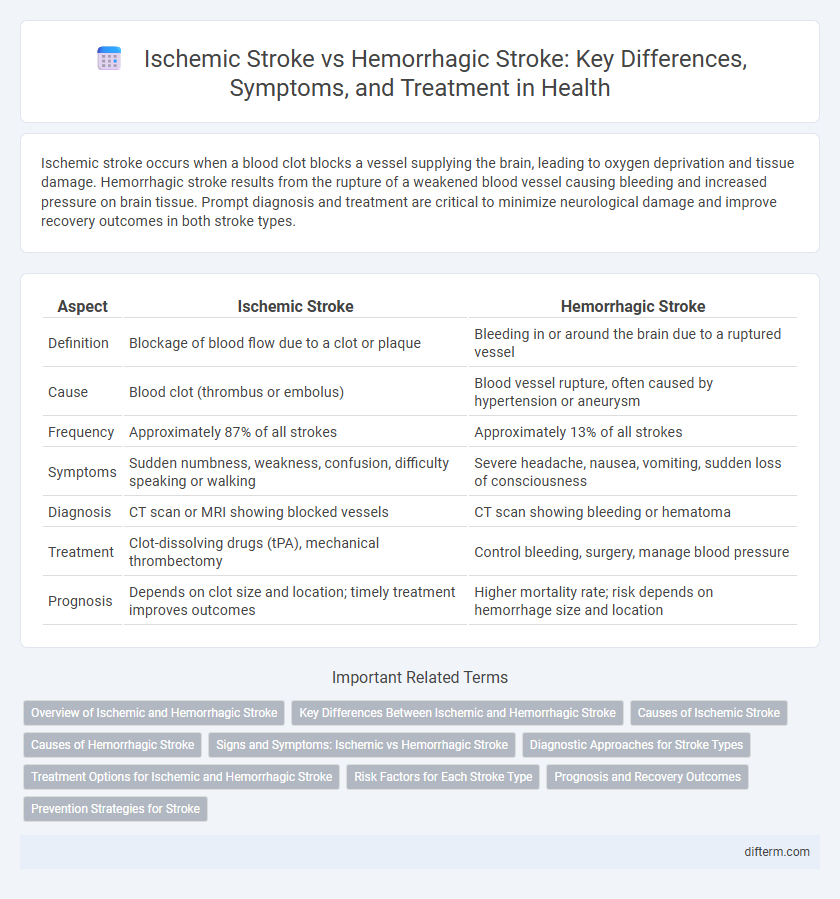Ischemic stroke occurs when a blood clot blocks a vessel supplying the brain, leading to oxygen deprivation and tissue damage. Hemorrhagic stroke results from the rupture of a weakened blood vessel causing bleeding and increased pressure on brain tissue. Prompt diagnosis and treatment are critical to minimize neurological damage and improve recovery outcomes in both stroke types.
Table of Comparison
| Aspect | Ischemic Stroke | Hemorrhagic Stroke |
|---|---|---|
| Definition | Blockage of blood flow due to a clot or plaque | Bleeding in or around the brain due to a ruptured vessel |
| Cause | Blood clot (thrombus or embolus) | Blood vessel rupture, often caused by hypertension or aneurysm |
| Frequency | Approximately 87% of all strokes | Approximately 13% of all strokes |
| Symptoms | Sudden numbness, weakness, confusion, difficulty speaking or walking | Severe headache, nausea, vomiting, sudden loss of consciousness |
| Diagnosis | CT scan or MRI showing blocked vessels | CT scan showing bleeding or hematoma |
| Treatment | Clot-dissolving drugs (tPA), mechanical thrombectomy | Control bleeding, surgery, manage blood pressure |
| Prognosis | Depends on clot size and location; timely treatment improves outcomes | Higher mortality rate; risk depends on hemorrhage size and location |
Overview of Ischemic and Hemorrhagic Stroke
Ischemic stroke occurs when a blood clot blocks or narrows an artery supplying blood to the brain, accounting for approximately 87% of all stroke cases. Hemorrhagic stroke results from the rupture of a weakened blood vessel causing bleeding in or around the brain, representing about 13% of strokes but with higher mortality rates. Early diagnosis through CT or MRI imaging is crucial for differentiating between ischemic and hemorrhagic stroke to guide appropriate treatment strategies.
Key Differences Between Ischemic and Hemorrhagic Stroke
Ischemic stroke occurs due to a blood clot blocking an artery in the brain, leading to reduced blood flow and oxygen deprivation, whereas hemorrhagic stroke results from a ruptured blood vessel causing bleeding in or around the brain. Key differences include ischemic strokes accounting for approximately 87% of all strokes and being primarily treated with clot-dissolving therapies, while hemorrhagic strokes comprise about 13% and often require surgical intervention to control bleeding. Distinct symptoms such as sudden weakness or numbness for ischemic stroke and severe headache with vomiting for hemorrhagic stroke aid in clinical differentiation.
Causes of Ischemic Stroke
Ischemic stroke occurs primarily due to the obstruction of blood flow to the brain, often caused by atherosclerosis, where fatty plaques narrow cerebral arteries, or by embolism, in which blood clots or debris travel from other parts of the body to block cerebral vessels. Risk factors such as hypertension, diabetes, high cholesterol, smoking, and atrial fibrillation significantly increase the likelihood of ischemic stroke by promoting clot formation and arterial damage. Understanding these underlying causes aids in targeted prevention and timely treatment to minimize brain tissue damage.
Causes of Hemorrhagic Stroke
Hemorrhagic stroke occurs when a weakened blood vessel ruptures, leading to bleeding in or around the brain, often caused by high blood pressure, aneurysms, or arteriovenous malformations. Chronic hypertension significantly increases the risk by damaging arterial walls, making them prone to leakage or rupture. Other factors such as head trauma, blood-thinning medications, and cerebral amyloid angiopathy also contribute to the development of hemorrhagic stroke.
Signs and Symptoms: Ischemic vs Hemorrhagic Stroke
Ischemic stroke symptoms often include sudden numbness or weakness in the face, arm, or leg, particularly on one side of the body, along with confusion, trouble speaking, or difficulty understanding speech. Hemorrhagic stroke typically presents with a sudden severe headache, nausea, vomiting, and altered consciousness due to bleeding in the brain. Both types require immediate medical attention to prevent permanent neurological damage.
Diagnostic Approaches for Stroke Types
Ischemic stroke diagnosis typically relies on computed tomography (CT) scans and magnetic resonance imaging (MRI) to detect blocked blood vessels and brain tissue damage. Hemorrhagic stroke identification focuses on CT scans to reveal brain bleeding and may involve cerebral angiography to locate vascular abnormalities. Accurate differentiation through imaging techniques is critical for timely treatment and improving patient outcomes in stroke management.
Treatment Options for Ischemic and Hemorrhagic Stroke
Ischemic stroke treatment primarily involves clot-dissolving medications such as tissue plasminogen activator (tPA) administered within a critical time window, alongside mechanical thrombectomy for large artery occlusions. Hemorrhagic stroke management focuses on controlling bleeding and reducing intracranial pressure through surgical interventions like aneurysm clipping or coiling, as well as blood pressure stabilization. Rehabilitation and supportive care are essential for both stroke types to optimize neurological recovery and prevent complications.
Risk Factors for Each Stroke Type
Ischemic stroke risk factors primarily include atherosclerosis, hypertension, diabetes mellitus, smoking, and atrial fibrillation, which contribute to blood clot formation or arterial blockage. Hemorrhagic stroke risk factors involve uncontrolled hypertension, aneurysms, arteriovenous malformations, bleeding disorders, and the use of anticoagulant medications. Both stroke types are influenced by age, family history, and lifestyle factors such as physical inactivity and excessive alcohol consumption.
Prognosis and Recovery Outcomes
Ischemic stroke, caused by a blockage in blood flow to the brain, generally has better prognosis and recovery outcomes compared to hemorrhagic stroke, which involves bleeding in the brain. Patients with ischemic stroke often benefit from timely interventions like thrombolysis, leading to improved neurological function and lower mortality rates. Hemorrhagic stroke typically results in higher mortality, more severe neurological deficits, and prolonged rehabilitation due to brain tissue damage from bleeding.
Prevention Strategies for Stroke
Effective prevention strategies for ischemic stroke primarily include managing risk factors such as hypertension, diabetes, and high cholesterol through medications and lifestyle changes like a balanced diet and regular exercise. For hemorrhagic stroke, controlling blood pressure is crucial, alongside avoiding excessive alcohol consumption and smoking cessation to reduce blood vessel rupture risk. Both stroke types benefit from routine medical checkups, anticoagulant or antiplatelet therapy when prescribed, and awareness of early symptoms to ensure timely intervention.
ischemic stroke vs hemorrhagic stroke Infographic

 difterm.com
difterm.com